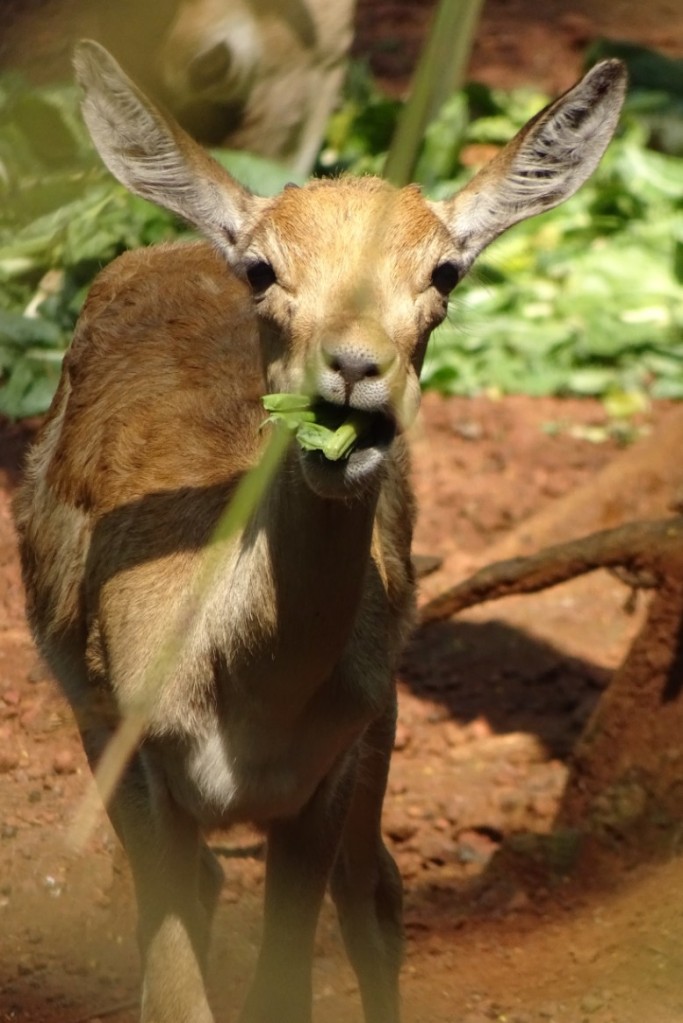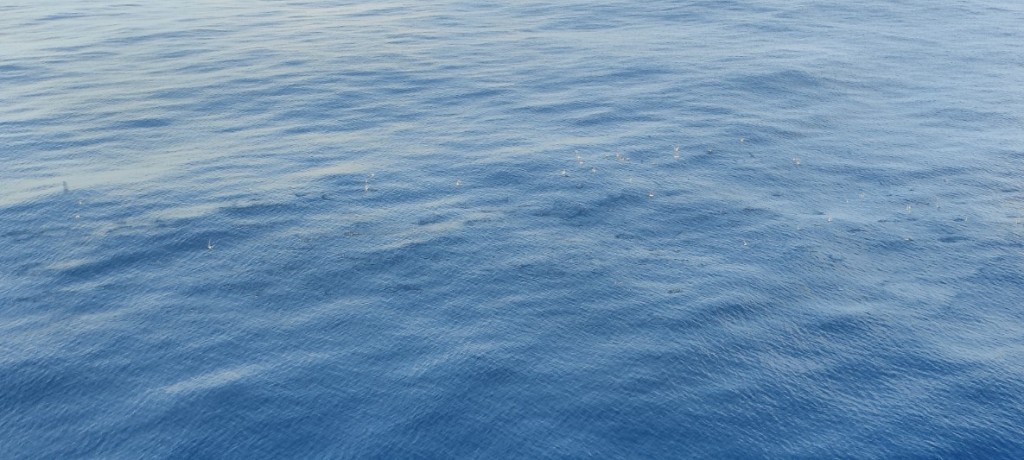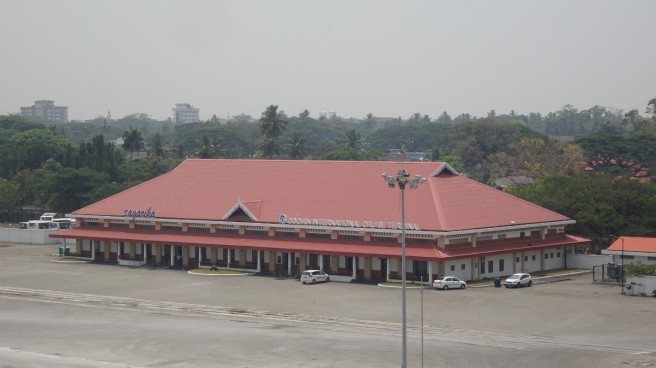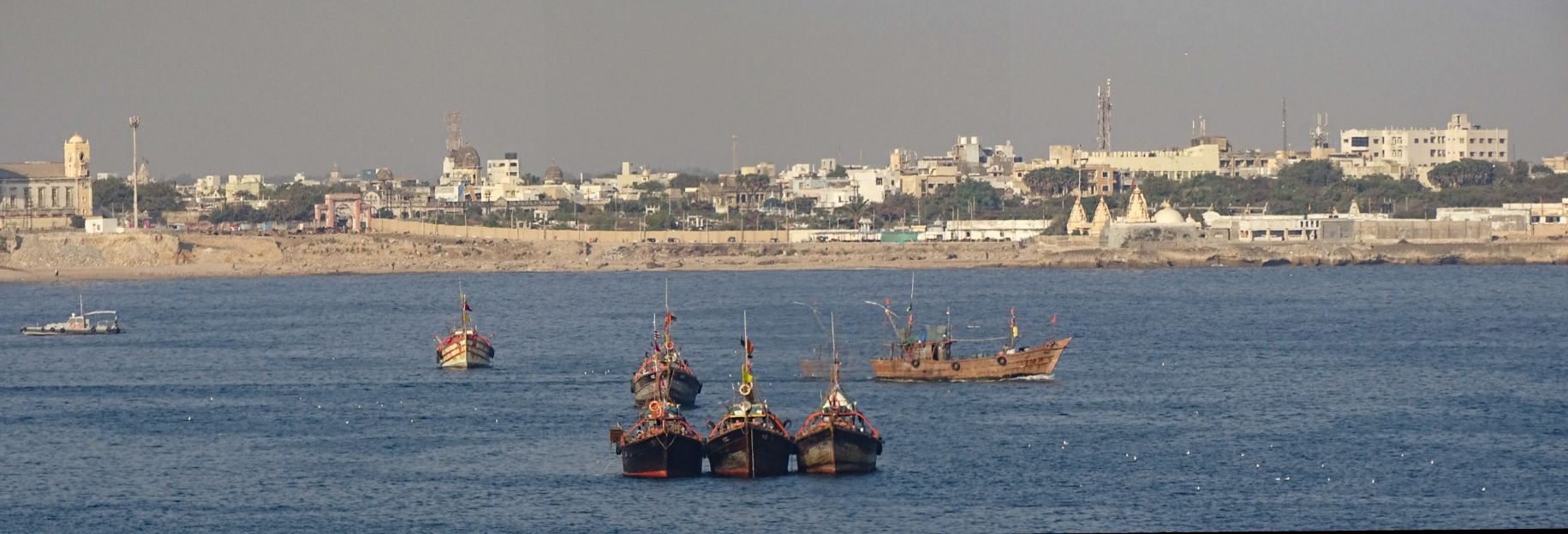Introduction
In my last post, T2330 – Magical Mumbai, I described our visit to Salalah in Oman, and primarily, our visit to Mumbai in India.
In this post I will cover our visits to the three other Indian ports on this cruise, Mormugão, Mangalore and Kochi, as well as the first of two ‘Crossing the Line’ celebrations we will have when we cross the Equator in each direction.
Mormugão, India
We sailed into the small port of Mormugão early in the morning, the day after we were in Mumbai. We were surprised to see another cruise ship already in port, it turned out that she belonged to an Indian cruise company, who are trying to grow the currently tiny cruise ship industry in India.
Carol and I have visited Mormugão twice before. On the 2019 Grand Voyage we stayed for two days. On the first day we did two ship’s tours, one by day and one in the evening, and on the second day we met up with an Indian friend and his family – you can read about this in my post D19GV – Early Departures. We were also in Mormugão earlier this year on our Around the World in 80 Days cruise, but this time it was so hot and humid that we decided to remain in the cool of the ship all day.
This time we thought we really ought to get off the ship, just to explore the small village at the end of the pier, and our friends Darien and Brian decided to come with us.
As we walked down the pier we were serenaded by a local band, who were performing close to a tourist information stand.
Our E-Landing cards (actually pieces of paper) were examined and stamped at a new terminal building – or should that be hut – halfway down the pier, and then checked again both as we left the hut and as we left the port gate.
Once we convinced all the taxi and tuk-tuk drivers that we really didn’t want a ride, we walked up the hill towards St. Francis Xavier church, about the only landmark in the vicinity.
Like all the other buildings around, the church was built of concrete, and was looking rather tired and forlorn.
I walked up some steps that ran up the side of the church to see if there was a better view from further up, but soon decided it was just to hot and humid to climb any further, and returned to the others who were sitting by the church.
We then decided it was more than time to return to the cool of the ship, so we made our way back down the hill and towards the port gate.
As we approached the gate, we were stopped by one of the guards, and told that we had to join a long queue of passengers with their cases, waiting to go through a security checkpoint. Fortunately he guided us past most of the queue, but the guards performing the checks seemed bemused by us – we were’t Indian like the rest of the queue, we didn’t have luggage, and couldn’t seem to understand why we wanted to go back to our ship so quickly – they kept saying “you want to go back to your ship???”. Finally we managed to negotiate our way through, our small bags now bearing ‘security checked’
labels for the other cruise line!

At the terminal hut there was further confusion, the officials there did not seem to know what to do with our E-Landing cards and initially wanted to keep them – but we insisted that we needed them for our next two ports, and after a lot of conferring the forms were eventually scanned and returned to us.
On the way back to the ship I took a couple of photographs of her.
Once on board we went straight to the Bookmark Cafe, and I swear there was steam from the back of my throat as I gratefully drank a lovely iced mocha coffee! We were all glad to rest in the cool of the ship for the rest of the day. While we were at dinner we set sail for our next port of call, Mangalore, which we would reach the next morning.
Mangalore, India
While we have visited the other three Indian ports on multiple times, this was a first visit to Mangalore for both Carol and me. We always love to be out on our balcony to watch the sail in to a port in the morning, especially when it is a new port. However we soon realised that this was very much a working port, and there was little to catch our eyes, or indeed my camera.
Many moons ago I worked for a well-known and very large internation IT company, and in the course of my work our department worked closely with people working in the companies offices in Bangalore, India. I became extremely good friends with a couple of the Indians, went out to stay with them, and to cut a long story short they both adopted me as their dadu, their honorary grandfather.
On previous visits to Indian ports on cruises they have been kind enough to travel some distance to come and meet Carol and I for the day, you can read about this for example in my post W1801 – Family reunion. On this cruise my honorary grandson Adi and his youngest daughter travelled to Mangalore to spend the day with us there.
Before we left the ship, we could see and hear musicians playing on the quayside, and as we queued to enter the terminal building for the inevitable stamping and multiple checking of our E-Landing cards, we could see traditional dancers performing.
We took a shuttle bus to the port gates, where Adi and daughter were waiting to pick us up. We had previously decided between us that we would go to the Pilikula Biological Park, and hopefully see lots of animals and birds in the extensive wildlife park there.
It took around half an hour to drive to the park, mostly through green countryside. Both Carol and I were delighted to have the chance to see these rural scenes, rather than the urban scenes which we usually get to see in the ports we visit.
Our tour of the windlife park began with some birds in cages, never easy to photograph.
Adi had predicted that the park would be very quiet on a weekday, but that notion was soon shattered – just after we entered the snake house, a hundred or so very cute and very excited little school-children poured in after us! They were obviously on a school visit to the park, but many of the children seemed just as interested in us as in the snakes!
We let the throng of children, and their teachers, go on ahead before continuing. We soon came to the tiger enclosure, and spotted one resting under the trees, alas facing the wrong way – the spots on the backs of its ears gave it away. Fortunately after a couple of minutes it turned its head partially, and then almost fully, towards us. Bingo!
There were so many lovely animals to see as we slowly made our way around the park, stopping frequently for water as it was so very hot and humid.
Eventually we had to stop for a longer rest, before tackling the final stages of the long walk around the park.
After a little while another group of school-children caught up with us. These were older, and seemed even more fascinated with us, and with Carol in particular – probably due to her blonde hair. Carol found herself mobbed, all the children wanted to know her name, and were intrigued by the fan she was wearing around her neck – they all wanted a go with it! Carol loves children, and was in her element with them, until the teachers decided enough was enough and directed them to move on.
We ambled along past more lovely animals, before finally returning to the park gates, where we were all glad to return to Adi’s air conditioned car!
Pilikula Park also contains some cultural attractions, and next we visited a couple of those. The first stop was at Guthu House, a preserved traditional manor house of the coastal landlords. Here Adi continued to be an excellent guide, telling us all about the furniture and artifacts around the house.
We then moved on to an Artisan Village, where we wandered around on foot. It was very quiet, apparently it was busy in the morning – I know a ship’s tour had gone there – and so the only demonstation we got to see was some pots being formed on a wheel.
While we were there, the older group of school-children caught up with us again, and once again mobbed Carol. With beaming faces, they showed her photos that they had taken of her, and once again were so keen to talk to her and even touch her and hold her hand. It was so lovely to see. Once again it was the teachers who eventually decided enough was enough, and called the children away to continue their school trip. We wondered afterwards whether the children would have seen English people before – certainly when we said we were from England and then asked whether they knew where that was, they said no. We also wondered whether when their parents asked about their day, their highlight might not be the animals, but instead meeting a white lady!
We then drove back to Mangalore where Adi took us to a very nice restaurant called The Village, where we enjoyed some light refreshments.
All too soon it was time for Adi to drive us back to the port, so that we could do battle with immigration once more, before boarding our ship. We both felt tired and drained by the heat and humidity all day, but absolutely elated from sharing such a wonderful day with my honorary family.
I know that Adi does not like to be thanked, but Carol and I must both give him a very big public thank you, not only for sharing such a wonderful day with us and being such a good guide, but also for the absolutely beautiful gift he gave us – this stunning peacock. It has pride of place in our cabin for now, and we have already decided where it will live on show at home.

Just before dinner we set sail for our final Indian port, Kochi, where we would arrive the following morning.
Kochi, India
Carol and I made sure we were out on our balcony to watch our sail into Kochi – we knew from before that there is plenty to see and photograph. Just before we came alongside, we were very interested to pass a ship called Kavaratti. Adi and his family had recently sailed on this ship on a cruise holiday to Lakshadweep, an archipelago of atolls and coral reefs off the coast of Kerala.
Carol and I have visited Kochi three times before. On the first visit Adi, his wife and family met up with us, and gave us a wonderful tour – including getting to pull the ropes on one of the traditional Chinese Fishing Nets – see my post W1801 – Family reunion.
On our second visit we did a wonderful ship’s tour to the Backwaters of Kerala – one that we would both thoroughly recommend and which you can read about in my post D19GV – Houseboat Heaven.
On our most recent visit, earlier this year on our 80 Days cruise, we elected to stay on the ship apart from a brief visit to some market stalls close to the terminal building.
This time we were planning to go out for a ride around the town on tuk-tuks – always a fun and great way to explore somewhere. However we were both still shattered from the day before, and expecting to be swimming on an island in the Maldives the next day, we decided that it was best to play the long game, and remain on the ship and rest in the cool air-conditioned cabin.
Late in the morning we did brave the heat, and the very persistent taxi/tuk-tuk drivers, to visit the market stalls. This time we bought a lovely elephant, which tones in beautifully with our peacock. We were relieved to be able to do our final pre-departure immigration face-to-face before returning to the ship.
Both Carol and I, in our own ways, were a little apprehensive and unsure before our first visits to India, many years ago now. Visiting India is certainly an experience – when you first arrive they say it can be like an assault on all your senses – but we both feel it is very much an experience you should embrace and enjoy. Over the course of our various visits over the years the country, and in particular its lovely people, have very much got under our skin, and we both felt very sad to be sailing away from it, for what is quite probably the last time.
As I said in my last post, during the pre-departure briefing, the Captain dropped the bombshell that we would not be going to the Maldives, but instead sailing directly to the Seychelles. Our adventures there are likely to be the subject of my next post.
Postscript 1
Carol and I are so lucky to have travelled the world so much. During the course of our various long voyages we have crossed the equator many times – before this cruise I think I have done it 10 times, and Carol 8 times.
Whenever the ship crosses the Equator, a ceremony is held called ‘Crossing the Line’, when King Neptune and his entourage come onto the ship, and punish the Captain and senior officers. I have explained and covered this ceremony many times in my blog posts, for example L1602 – Crossing the line and W1702 – Crossing the Line 3.
Here are some photos of our latest ceremony, held to mark crossing the Equator yesterday afternoon.
Postscript 2
Regular readers might remember all the rough seas that Carol and I endured crossing the Atlantic ocean each way a month or two ago. Yesterday was the complete opposite – it was like sailing on a lake, the sea was so flat calm and smooth. It was also an astonishing blue colour, and was punctuated every so often by shoals of flying fish. Just magical!






























































































































































































































































































